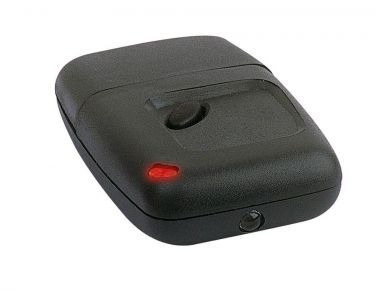IR Controlled Fob
IR Controlled Fob
Application
This infra red remote control switching device is designed for use in those many instances which can occur in the planning of an access control or security system where remote switching is desirable. The need for remote switching is many fold and could arise, for example, from one of the following situations:
Mobile Switching – Occasionally electromagnetic locks, securing gates or barriers, are switched from vehicles over distances of metres.
Barrier Free Switching – Some authorized users may be unable to access conventional switches and may prefer the convenience of a hand held fob (or transmitter).
Vandal Resistant Switching – The receiver can be mounted behind a sheet of protective glass or Perspex (offers little or no opportunity for vandalism.
The IRR/IRF Package
This is a two part system comprising one of two choices of receiver with an appropriate number of fobs:
External Receiver
The IRR.EXT Infra Red Receiver is designed for surface mounted external installations and is equipped with a suitably rated mounting box.
Electrical Specification
Voltage – 12Vdc only
Dry Contacts – Changeover relay rated
1 Amp resistive
Internal Receiver
The IRR.INT Infra Red Receiver is designed for flush fitting strictly on internal installations.
Electrical Specification
Voltage – 12Vdc only
Dry Contacts – Changeover relay rated
1 Amp resistive
Important note -
Both types of receiver must be mounted within direct line of sight of the operator. Where controlled access is necessary in both directions, i.e. in and out, two receivers will be required.
Fobs (Transmitters)
The IRF Infra Red Fob is a user friendly hand held transmitter with an effective range of between 3 metres (direct sunlight) and 15 metres (normal internal conditions). Each fob has a battery life of over 5,000 operations. Fobs can be reprogrammed should the need arise.
Code Versatility
The ability of this system to accept or deny a code is a function of the compatibility between the fob (transmitter) and the receiver. Each fob contains a coded ‘key’ that transmits a fixed length 24 bit code. This code comprises two distinct parts:
Site Code – 0 - 255 options (or 28)
PIN – 0 - 65,535 options (or 216)
Dipswitch settings on the reverse of the receiver board ensure the IRR/IRF can be used in three different modes:
Single ‘Common’ Code Mode (Site Code & PIN)
In this mode all the fobs are coded to the same differ (a combination of the Site Code and PIN) and the receiver (configured accordingly) acts as a switching device.
Twin Code or ‘Access Control’ Mode (Site Code & PIN)
In this mode a higher level of security is achieved. The receiver is no longer acting as a switching device but is connected to an access control system accepting Wiegand signals in 26-bit format. Each fob has its own PIN (or differ) in addition to the common Site Code and can be recognized or voided by the access control system in the same manner as any card or proximity fob.
Degraded Mode (Site Code Only)
In this mode, the Site Code is used to identify each fob. The receiver is configured to recognize this part of the code only and to switch power accordingly. This is also known as a ‘reverse master’ system and employs, for example, the same fobs as those used in the Twin Code system and described above - but at a lower level. This mode could be used, for example, as a low level security check at a car park barrier allowing all users access irrespective of their PIN.
Reset Times
The ‘relay on’ time can be set to the following:
1 Second, 5 Seconds, 10 Seconds & 30 Seconds
How to Specify or Order
IRR.EXT - Infra Red External Receiver
IRR.INT - Infra Red Internal Receiver
IRF - Infra Red Fob
Finishes
No finish on this part


